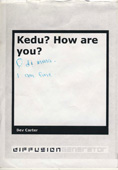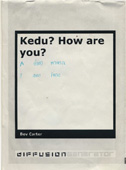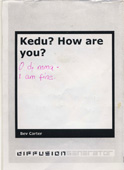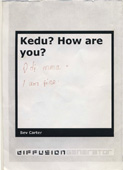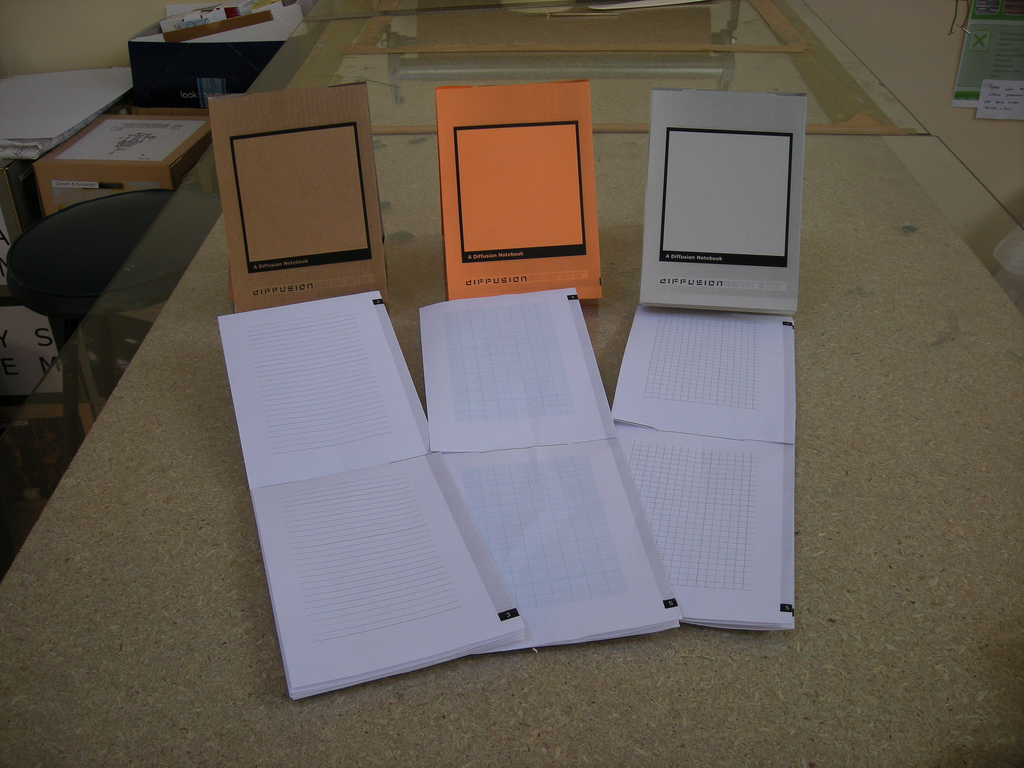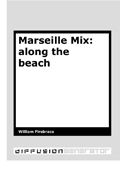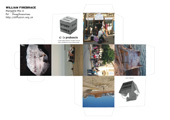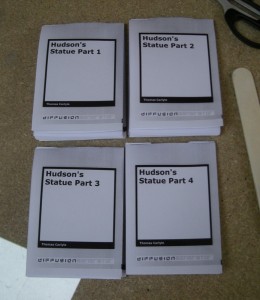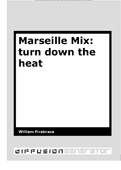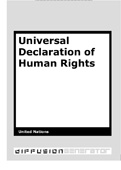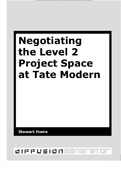Articles by Giles Lane
Giles Lane is founder and co-director of Proboscis. He conceived of and developed the Diffusion eBook format with Paul Farrington and designed the Proboscis StoryCube.


Download A4 | US Letter PDF 924Kb
About : In 2008 Cartoon de Salvo created Hard Hearted Hannah and Other Stories. Each night is an brand new, entirely improvised adventure. To begin we elicit a ‘simple title of, for example, a movie that’s never been made’ from an audience member. Then they choose a few songs from a playlist of our band’s repertoire. We think for a few seconds and then we start, working in those songs and the show lasts between 50 mins and up to 2 hours. We never limited ourselves to any place, genre or time. We place implicit trust in each other’s narrative instinct. The idea is, having been exposed to stories all of our lives, we all have a very developed sense of what should happen next.
This series of Diffusion eBooks explores some of the patterns that came randomly out of the air, as told by Brian Logan and illustrated by Alex Murdoch. The first two books are ‘Classics from Nowhere‘ – where we tapped into story structures from myths and fairytales and ‘World of the Strange and Bizarre’ where our unconcious minds led us into some very odd situations indeed. Over the coming months we’ll be publishing four more books on the themes of mysteries, music, silent characters and relationships.
Look out for the show on tour at the Plymouth Drum from 28th April – 25th May, The Showroom, Chichester on 6th May, Tobacco Factory, Mayfest, Bristol from 7th – 9th May and this summer at the Edinburgh Festival Theatre Workshop as part of the British Council Showcase.
Hard Hearted Hannah and Other Stories is created by Cartoon de Salvo.
Co-commissioned by Farnham Maltings and the Lyric, Hammersmith
Published April 2009
Cartoon de Salvo are of the few companies in the UK working with whole story, rather than sketch-based, improvisation formats. Read more about the artistic process on their blogs at www.theatrevoice.com and visit www.cartoondesalvo.com
Cartoon de Salvo is Rebecca Hurst, Brian Logan and Alex Murdoch with Neil Haigh, Paul Kissaun and James Turnbull.

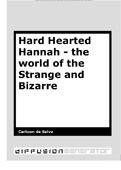
Download A4 | US Letter PDF 850Kb
About : In 2008 Cartoon de Salvo created Hard Hearted Hannah and Other Stories. Each night is an brand new, entirely improvised adventure. To begin we elicit a ‘simple title of, for example, a movie that’s never been made’ from an audience member. Then they choose a few songs from a playlist of our band’s repertoire. We think for a few seconds and then we start, working in those songs and the show lasts between 50 mins and up to 2 hours. We never limited ourselves to any place, genre or time. We place implicit trust in each other’s narrative instinct. The idea is, having been exposed to stories all of our lives, we all have a very developed sense of what should happen next.
This series of Diffusion eBooks explores some of the patterns that came randomly out of the air, as told by Brian Logan and illustrated by Alex Murdoch. The first two books are ‘Classics from Nowhere’ – where we tapped into story structures from myths and fairytales and ‘World of the Strange and Bizarre‘ where our unconcious minds led us into some very odd situations indeed. Over the coming months we’ll be publishing four more books on the themes of mysteries, music, silent characters and relationships.
Look out for the show on tour at the Plymouth Drum from 28th April – 25th May, The Showroom, Chichester on 6th May, Tobacco Factory, Mayfest, Bristol from 7th – 9th May and this summer at the Edinburgh Festival Theatre Workshop as part of the British Council Showcase.
Hard Hearted Hannah and Other Stories is created by Cartoon de Salvo.
Co-commissioned by Farnham Maltings and the Lyric, Hammersmith
Published April 2009
Cartoon de Salvo are of the few companies in the UK working with whole story, rather than sketch-based, improvisation formats. Read more about the artistic process on their blogs at www.theatrevoice.com and visit www.cartoondesalvo.com
Cartoon de Salvo is Rebecca Hurst, Brian Logan and Alex Murdoch with Neil Haigh, Paul Kissaun and James Turnbull.

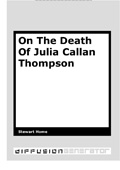
Download A4 | US Letter PDF 390Kb
About : A look at the death of 35 year-old Julia Callan-Thompson in west London in 1979, showing how the authorities failed to fully investigate the circumstances.
Published March 2009
Stewart Home is an artist who has used social networking sites such as MySpace as the location for much of his non-gallery work in recent years. He is also the author of many books of fiction and cultural commentary, including 69 Things to do With a Dead Princess (Canongate, 2002), and The Assault on Culture: Utopian current from Lettrisme to Class War (AK Press 1991). His latest novel is Memphis Underground (Snowbooks, 2007). Online resources relating to Stewart Home’s work can be found at
www.stewarthomesociety.org

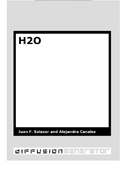
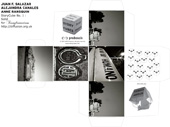
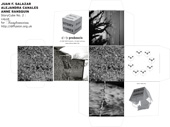
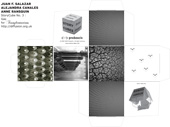
Download
H2O eBook A4 | US Letter PDF 258Kb
H2O StoryCubes A4 only PDF 3.83Mb
About : H2O looks at the materiality of water to speculate on its cultural and political significance at the turn of the 21 century. We can begin reflecting on who we are and what we want to become by understanding the place that water holds in social life and cultural change.
Published March 2009 in the Diffusion Transformations series
Alejandra Canales is a Chilean-born performance artist and independent filmmaker, concerned with the social and political dimensions of artistic practice. Based in Sydney since 1998, she has undertaken studies in film and video production and has worked in several roles for independent films. In 2005 she completed a Master Honours at AFTRS where she directed two documentaries A Silence Full of Things and Switch on the Night. Currently she is a recipient of a scholarship to complete a Doctorate of Creative Arts at University of Wester Sydney where she works on the project Rendering Water: a documentary fiction on the cultural future of water. She also received an Ian Potter Cultural Trust grant to progress on her new multi-platform documentary film Solid_Liquid_Gas_H20.
Anne Ransquin is a Belgian photographer and historian working across photography, design, film and community media. She has participated in as well as conducted several photographic workshops such us Suburbancrossings digital photography workshop with young refugees from Sudan and Chad in collaboration with Information and Cultural Exchange and the University of Western Sydney. She has also contributed to several independent film projects in Chile, Australia and Belgium in her capacity as a still photographer as well as an assistant director. Currently she is developing a photodocumentary project in Arles and will assist Spanish artists at the Biennal of Contemporary Arts in La Havana/Cuba (March 2009). She is a member of the Belgian photographers collective, Collectif Caravane.
Juan Francisco Salazar is a Chilean born, Sydney-based media anthropologist and video maker. He lectures in communication and media studies at the University of Western Sydney where he is also a research member in the Centre for Cultural Research. He has published extensively in areas of indigenous and community media, climate change and social change. He has produced several documentaries and experimental films which have been exhibited internationally.

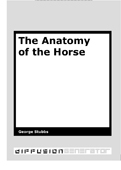
Download A4 | US Letter PDF 1.52Mb
Selected and Introduced for Short Work by Paul Bonaventura, Senior Research Fellow in Fine Art Studies at the Ruskin School of Drawing & Fine Art, University of Oxford
George Stubbs (1724-1806) is recognised as one of the most original artists of the eighteenth century. His singular ability to translate the study of nature into extraordinarily balanced compositions marks him out from all other practitioners in the field of animal painting. Although his wide-ranging subjects also included portraits, conversation pieces and paintings of domestic and exotic animals, Stubbs is best known for painting horses, and his reputation was established among noblemen devoted to racing and breeding horses who recognised in him a shared sympathy for the English countryside and rural ways of life.
Stubbs’s career as a painter of horses was rooted in his extraordinary knowledge of equine make-up. In his early thirties, between 1756 and 1758, Stubbs spent eighteen months dissecting and drawing the bodies of up to a dozen horses at a remote farmhouse at Horkstow in Lincolnshire. Out of this unflinching and painstaking industry came a publication called The Anatomy of the Horse and a steadfast commitment to the pursuit of reality.
In A Memoir of George Stubbs, the only contemporary account of the artist’s life and career, Ozias Humphry described Stubbs’s working methods in Horkstow:
‘The first subject which was procured was a horse which was bled to death by the jugular vein – after which the arteries and veins were injected – Then a bar of iron was suspended from the ceiling of the room, by a teagle of iron to which iron hooks were fixed – under this bar a plank was swung at 16 inches wide for the horse feet to rest upon – and the horse was suspended to the bar of iron by the above mentioned hooks which was fastened into the opposite side of the horse that was intended to be designed, by passing the hooks through the ribs and fastening them under the back bone – and by these means the horse was fixed in the attitude which these prints represent and continued hanging in the posture six or seven weeks, or as long as they were fit for use –
His drawings of a skeleton were previously made – and then the operations upon this fixed subject were thus begun. He first began by dissecting and designing the muscles of the abdomen – proceeding through five different layers of muscles till he came to the peritoneum and the pleura, through which appeared the lungs and the intestines – after which the bowels were taken out, and cast away. –
Then he proceeded to dissect the head, by first stripping off the skin and after having cleared and prepared the muscles, et cetera, for the drawing, he made careful designs of them and wrote the explanation which usually employed him a whole day.
Then he took off another lay of muscles which he prepared, designed, and described, in the same manner as is represented in the book – and so he proceeded until he came to the skeleton – … It must be noted that by means of the injection [of wax or tallow] the muscles, the blood vessels, and the nerves, retained their form to the last without undergoing any change of position.
In this manner he advanced his work by stripping off skin and clearing and preparing as much of the subject as he concluded would employ a whole day to prepare design and describe, as above related, till the whole subject was completed.’
The first edition of The Anatomy of the Horse featured eighteen plates etched by the artist from his drawings, and more than 50,000 words of meticulous scientific text, and its publication in 1766 earned Stubbs instant and lasting appreciation, not least from the animal painters who followed him. ‘[Try] to imagine, for a moment,’ wrote Sir Alfred Munnings, President of the Royal Academy of Arts, ‘Stubbs at his work setting up and dissecting horse-carcasses in the barn there, making detailed drawings, for plate after plate with all the names of the muscles and finally engraving each plate himself, this latter part of the work, an entirely new departure for him, being spread over something like a period of six years, we may then begin to grasp the magnitude of this labour of love.’
Forty-two of Stubbs’s drawings for The Anatomy of the Horse survive in the Royal Academy Collections. Of these, eighteen are scrupulously finished on fine paper, made to be engraved for publication, and drawn to the same scale. The other twenty four are working drawings. Of the eighteen engravings in the accompanying eBook, many have drawings in Piccadilly that directly relate to Stubbs’s original plates. Fifteen of these are from the old set of eighteen, and five belong to the twenty-four working drawings.
The Anatomy of the Horse is a supreme achievement, but Stubbs’s belief in scientific inquiry as the basis for art should not blind us to the fact that his subsequent portraits of thoroughbed racehorses are more than just paintings of record for they absorb us on so many levels; by engaging the personality and feeding the spirit, they compel examination. To see Stubbs’s work solely as a reflection of the Enlightenment aspirations of his aristocratic clients is to neglect its phenomenal aesthetic quality and its lasting, but frequently overlooked impact on the later development of western art.
Paul Bonaventura
Spring 2009

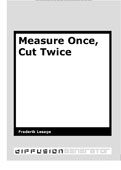
Download A4 | US Letter PDF 1.1Mb
About : Measure Once, Cut Twice is an examination of how an arts organisation like Proboscis produces creative collaborative artworks – specifically their ‘participatory sensing’ project, Snout. The concept of cutting is developed as a means of understanding how objects, people, and practices temporarily come together to produce exceptional moments of social engagement.
Published March 2009
Frederik Lesage is a PhD candidate in the Media and Communications department of the London School of Economics and Political Science. His doctoral thesis deals with the collective construction of artistic conventions among artists who design and use information and communication technologies.

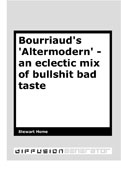
Download A4 | US Letter PDF 412Kb
About : A critical look at the Altermodern Tate Triennial 2009 and the incoherent theory underpinning it. Appended with an account of the International Necronautical Society talk that was one of a number of events used to frame the Nicolas Bourriaud’s Tate Britain show.
Published March 2009
Stewart Home is an artist who has used social networking sites such as MySpace as the location for much of his non-gallery work in recent years. He is also the author of many books of fiction and cultural commentary, including 69 Things to do With a Dead Princess (Canongate, 2002), and The Assault on Culture: Utopian current from Lettrisme to Class War (AK Press 1991). His latest novel is Memphis Underground (Snowbooks, 2007). Online resources relating to Stewart Home’s work can be found at
www.stewarthomesociety.org


Download A4 | US Letter PDF 260Kb
About : These 30 epithets form a kind of experimental prose poem that uses the 140 character constraint of the micro-blogging service Twitter as its structure. They were composed as a contribution to the catalogue for Larissa Hjorth’s CU: the presents of co-presence, a project exploring SMS culture. Each epithet was prefaced with the hashtag #tweetome and first published via Twitter on February 22nd 2009.
Published March 2009
Giles Lane is an artist, researcher and teacher. He founded and is co-director of Proboscis, a non-profit creative studio based in London where, since 1994, he has led projects such as Urban Tapestries; Snout; Mapping Perception; Experiencing Democracy; Everyday Archaeology; and Private Reveries, Public Spaces. Giles is a Visiting Tutor on the MA Design Critical Practice at Goldsmiths College (University of London) and is a Research Associate of the Media and Communications Department at London School of Economics. Giles was elected a Fellow of the Royal Society of Arts in 2008 for his contribution to community development through creative practice.

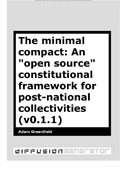
Download A4 | US Letter PDF 426Kb
About : The minimal compact: An “open source” constitutional framework for post-national collectivities (v0.1.1)
First written and published online in 2003, the Minimal Compact is a manifesto for creating a constitution between people, based on open-source software concepts and practices, that goes beyond the framework of the nation state.
Published March 2009
Adam Greenfield is a writer and critical futurist, and as of 2009 holds the position of Head of Design Direction, Service and User Interface Design for Nokia. He has spent the past ten years exploring the intersection of technology, design and culture, with a strong focus on issues around ubiquitous computing. His 2006 book on the subject, Everyware, has been acclaimed as “groundbreaking,” “elegant,” and “soulful” by Bruce Sterling, and “gracefully written, fascinating, and deeply wise” by Wired’s Steve Silberman. His book The City Is Here For You To Use (Do Projects, forthcoming) explores the impact of these technologies on urban form and metropolitan experience. Previously a rock critic, San Francisco bike messenger, PSYOP sergeant, and head of the information architecture department for the Tokyo office of the notorious early Internet consultancy Razorfish, Greenfield most recently co-taught the “Urban Computing” course at New York University’s Interactive Telecommunications Program with Kevin Slavin. He currently lives and works in Helsinki, Finland, and blogs at speedbird.wordpress.com. His Twitter feed can be found at twitter.com/agpublic.

This work is licensed under a Creative Commons Attribution-Noncommercial-Share Alike 3.0 Unported License

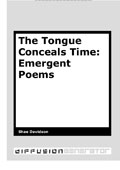
Download A4 | US Letter PDF 281Kb
About : The Tongue Conceals Time uses randomly grouped words and phrases from print and electronic media to create poems that celebrate the hints of chaotic beauty found in happenstance associations. The poems and tales embrace absurdism as well as the emergence of patterns and structures in seemingly dissociated material.
Published February 2009
Historian and poet Shae Davidson currently serves as a member of the Creative Synthesis Collaborative, and has worked as an instructor, researcher, and museum director. His prior publications include historical essays, reviews, and policy analysis; his poetry has appeared in journals in Canada, the United Kingdom, and the United States.

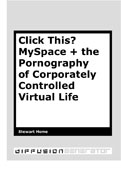
Download A4 | US Letter PDF 444Kb
About : An account of eighteen months of activity on MySpace, which led to being accorded the status of the platform’s top UK blogger; and ending with the lesson that it is better to quit while you’re ahead when dealing with corporate social networking sites, and thus avoid becoming locked into them.
Published February 2009
Stewart Home is an artist who has used social networking sites such as MySpace as the location for much of his non-gallery work in recent years. He is also the author of many books of fiction and cultural commentary, including 69 Things to do With a Dead Princess (Canongate, 2002), and The Assault on Culture: Utopian current from Lettrisme to Class War (AK Press 1991). His latest novel is Memphis Underground (Snowbooks, 2007). Online resources relating to Stewart Home’s work can be found at
www.stewarthomesociety.org

Download
Kedu – eBook 1 A4 only PDF 644Kb
Kedu – eBook 2 A4 only PDF 608Kb
Kedu – eBook 3 A4only PDF 649Kb
Kedu – eBook 4 A4 only PDF 650Kb
Kedu – eBook 5 A4 only PDF 632Kb
About : eBooks help to promote ongoing communication between students in Umulogho Village, Nigeria and students in Watford schools.
Bev Carter’s eBook A Little Something About Me (generated by with support from Proboscis) was used to assist a series of workshops in six schools in Watford during 2008 to communicate through words, paintings and photographs the life, experiences and interests of students attending a secondary school in Umulogho, a rural village in Imo State, Nigeria, West Africa.
During school workshops copies of this eBook were handed out to the students and a discussion was encouraged and facilitated by Bev. The pupils really liked the eBook and it served to generate more curiosity and questions about life in Umulogho. As part of the process another eBook created to capture all the thoughts and enquries the students had.
The next eBook was called ‘Kedu?‘ This means ‘How are you? in Igbo, the main language spoken in Umulogho Village. This was a collection of further questions from students in Watford using pictures created by Umulogho students to give them added visual interest. In July 2008 copies of the ‘Kedu’ eBook were hand delivered to Umulogho Village by Tony Amaechi, a Trustee of Friends Out There, and some Umulogho Village students then filled in their response to the questions in the eBook. Five eBooks were collected by Tony on his return to the UK and some students told Tony that they had enjoyed filling in the eBooks, were thrilled to see their paintings scanned in to them and were happy to know that students in the UK were interested in them, their dreams and concerns.

In October 2008 the completed Kedu eBooks were taken back to some of the schools in Watford that had asked the original questions. The students were amazed and pleased to see they really had been given some answers to their questions, such as ‘are there any crocodiles in the village stream? – some Umologho students had seen some and others hadn’t. The eBooks got the Watford students talking about what time they wake up in the morning and what they do before school as most students in Umulogho were awake by 5.30 am and had gone to the village stream and back to collect water before going to school. The Kedu eBooks also gave the Umulogo students a space to ask some questions that they had for the Watford students such as ‘what seasons do you have in England?’ and ‘what religions do you have?’
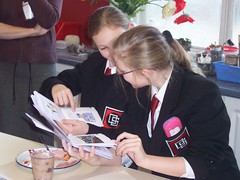
The next stage will be to create another eBook to continue the communication between the schools in Umulogho and Watford. The eBook is an excellent resource for schools: students like the pocket sized feel, it’s a great way to capture conversations and enquiries and, even though the school in Umulogho Village doesn’t yet have a computer or internet access, we were still able to send and receive paper copies – using more traditional means of connection and communication.
Bev Carter
February 2009
For more information please contact Bev Carter (Friends Out There)
Published February 2009
Proboscis is currently hosting three Diffusion residents:
- Alex Murdoch, founder and director of theatre company Cartoon de Salvo who is developing a series of eBooks re-presenting Hard-Hearted Hannah, a long-form improvisation show that toured for 53 performances in 2008.
- Stewart Home, artist and writer, who is re-publishing out of print texts and new pieces.
- Marie-Anne Mancio writer and curator, who is creating an ‘encyclopedia’ of eBooks about 1970s experimental performance artists, The Theatre of Mistakes.
Follow their publications in the Residencies Series.

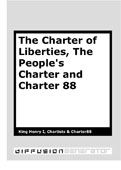
Download A4 | US Letter PDF 290Kb
About : This eBook contains the texts of three key charters of rights spanning almost 900 years. The first, originally published in 1100, was the Charter of Liberties confirmed by King Henry I on securing his throne despite widespread opposition. His reign was subsequently regarded as a golden age of the rule of law and justice, particularly as it was followed by a brutal civil war.
The People’s Charter of 1838 was a response to the Great Reform Act of 1832 which widened the franchise, but stopped short of universal male suffrage, secret ballot, and other elements of parliamentary reform. It was supported by working class ‘Chartists’ seeking representation through enfranchisement and participation in the parliamentary process through MP’s being paid (not having to rely on private wealth).
Charter 88 was a demand for a written constitution, electoral and constitutional reform for the UK arising out of the period of the Thatcher government. Many of its demands are still unmet and pertinent today – visit Unlock Democracy to follow their recent projects.
First Published in 1100, 1838 and 1988
Sourced from Wikipedia, www.thechartists.net and www.britannia.com


Download A4 | US Letter PDF 317Kb
About : The 1689 Bill of Rights is an Act of the English Parliament setting out the rights of citizens and the relationship between the Crown and Parliament. It was passed, after the Glorious Revolution of 1688, by the dual monarchs William III and Mary II and declared James II’s flight from the country to be an abdication of the throne. The Bill of Rights is one of the cornerstones of the ‘unwritten’ English constitution, as well as a predecessor of the US Bill of Rights and is also enshrined in the laws of many countries of the former British Empire.
First Published 1689
Sourced from The Constitution Society

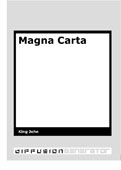
Download A4 | US Letter PDF 390Kb
About : Magna Carta is commonly perceived to be the foundation of English rights and liberties, but in fact was a legal charter forcing King John to concede rights, follow legal procedures and agree to be bound by the law, mainly for his barons’ benefit. The 1297 version remains in law in England and Wales and guarantees these rights for all “freemen” – most notably the writ of habeus corpus. Magna Carta is often cited as a milestone on the development of English common law, constitutional law and the US Constitution.
First Published 1215
Sourced from The Constitution Society

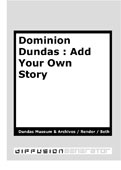
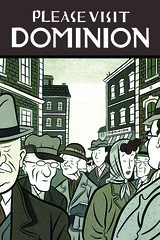
Download A4 | US Letter PDF 1.9Mb
About : The Dominion Dundas eBook has been produced to accompany the exhibition of Canadian cartoonist Seth’s model city at the Dundas Museum & Archives (Dundas, Ontario, Canada). Organized by RENDER (University of Waterloo), Dominion takes Seth’s distinct vision of urban space off the printed page and into the format of an installation infused with the cartoonist’s characteristic air of melancholy and ambiguous nostalgia. This eBook features images of 10 of Seth’s buildings and has been developed as a story collecting tool to accompany the exhibition, encouraging museum visitors to reflect on their own town’s history and to share stories of buildings, people and sites of the area.
Published February 2009
Seth is the cartoonist behind the painfully infrequent comic book series Palookville. Currently he is serializing the story Clyde Fans between its covers. This is a task that has gone on for a decade now and will likely continue for several more years. His books include It’s A Good Life I You Don’t Weaken, Wimbledon Green, Bannock, Beans and Black Tea, and the above mentioned Clyde Fans Book One. One volume of his sketchbooks has appeared under the title Vernacular Drawings and another will likely appear within the following few seasons. His books have been translated into 5 languages.
As a book designer he has worked on a variety of projects including the recent Penguin reprinting of The Portable Dorothy Parker. He is the designer of the 25 volume series The Complete Peanuts and the upcoming two volume series on Canadian master cartoonist Doug Wright. As an illustrator/hack he has produced commercial works for almost all of the major Canadian and American magazines. His work has appeared inside and on the cover of the New Yorker. Last year he serialized the story George Sprott (1894-1975) in the New York Times for 25 weeks and will appear in an expanded form as a book in the spring of 2009.
Seth lives in Guelph, Ontario with his wife and three cats and appears to rarely leave the basement.
For more information about RENDER and the Dundas Museum visit:
www.render.uwaterloo.ca
www.dundasmuseum.ca

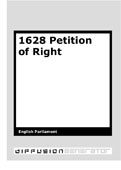
Download A4 | US Letter PDF 266Kb
The Petition of Right was a landmark episode in the history of English, and later British, democracy. As a check to the increasingly despotic rule of King Charles I, the English Parliament sought to confirm many of the rights and privileges established through earlier Acts against violation by the king. The Petition of Right confirmed Parliament’s exclusive right to levy taxes, the writ of habeus corpus against imprisonment without trial, no martial law in time of peace or billeting of soldiers in civilian homes. Key figures such as Sir Edward Coke and John Pym were the driving forces behind its drafting.
First Published 1628
Sourced from The Constitution Society


Download A4 | US Letter PDF 266Kb
The Charter of the Forest is the lesser known companion to the Magna Carta issued during the reign of King Henry III. In force from 1217 until 1971, recent interest in the charter has focused on the very real rights, privileges and protections that it offered to common people to use the Royal Forests for forage, grazing and fuel. Under a succession of previous monarchs these forests had been greatly enclosed and harsh penalties imposed, including death and mutilation, which the charter repealed.
First Published 1217
Sourced from The Constitution Society


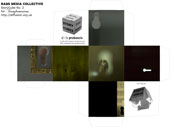

Download A4 only PDF 660Kb
About : 3 Cubic Conundrums by Raqs Media Collective, 2009
– The Curse of Invariable Good Fortune
– Door to Door to Door
– The Fugitive Never Escapes Himself
Published January 2009 in the Diffusion Transformations Series
The Raqs Media Collective (Jeebesh Bagchi, Monica Narula & Shuddhabrata Sengupta) has been variously described as artists, media practitioners, curators, researchers, editors and catalysts of cultural processes. Their work, which has been exhibited widely in major international spaces and events, locates them squarely along the intersections of contemporary art, historical enquiry, philosophical speculation, research and theory – often taking the form of installations, online and offline media objects, performances and encounters. They live and work in Delhi, based at Sarai, Centre for the Study of Developing Societies, an initiative they co-founded in 2000. They are members of the editorial collective of the Sarai Reader series, and have curated “The Rest of Now” and co-curated “Scenarios” for Manifesta 7.

Download
Portrait Versions
Multipurpose classic A4 | US Letter PDF 800Kb | book A4 | US Letter PDF 800Kb
Blank classic A4 | US Letter PDF 144Kb | book A4 | US Letter PDF 144Kb
Graph classic A4 | US Letter PDF 720Kb | book A4 | US Letter PDF 720Kb
Lined classic A4 | US Letter PDF 650Kb | book A4 | US Letter PDF 650Kb
Squared classic A4 | US Letter PDF 660Kb | book A4 | US Letter PDF 660Kb
Music classic A4 | US Letter PDF 650Kb | book A4 | US Letter PDF 650Kb
Storyboard classic A4 | US Letter PDF 150Kb | book A4 | US Letter PDF 150Kb
Landscape Versions
Multipurpose classic A4 | US Letter PDF 560Kb | book A4 | US Letter PDF 560Kb
Blank classic A4 | US Letter PDF 144Kb | book A4 | US Letter PDF 144Kb
Graph classic A4 | US Letter PDF 220Kb | book A4 | US Letter PDF 220Kb
Lined classic A4 | US Letter PDF 650Kb | book A4 | US Letter PDF 650Kb
Squared classic A4 | US Letter PDF 660Kb | book A4 | US Letter PDF 660Kb
Music classic A4 | US Letter PDF 650Kb | book A4 | US Letter PDF 650Kb
Storyboard classic A4 | US Letter PDF 150Kb | book A4 | US Letter PDF 150Kb
About : Inspired by the enthusiasm for Paper/Digital Hybrids at the recent PaperCamp in London, we have prepared a range of Diffusion Notebooks. Proboscis has designed custom Diffusion eNotebooks for many of our own projects going back five or more years, however we’d not created generic ones that could be used off the cuff. This selection of Notebooks is based on some simple notepaper designs that we like to use: blank and lined pages, graphs and squares. Each Notebook is made up of 4 sheets of paper with 14 pages for you to use. The Multipurpose Notebook combines five types on 7 sheets (26 pages). Print them out using different paper stocks and colours for different effects. Once you’ve filled them up, take them apart, scan the pages and you’ve got an instant digital shareable notebook.
Customisations : We are happy to design customised variations of these Notebooks (with more pages, additional page designs or various combinations of the ones used here). Please add your suggestions to the comments section below and we’ll endeavour to oblige. We are also happy to take on design commissions to create Notebooks for exhibitions, conferences or other activities.
Update : two new variations have been added – music staves and storyboards.
Update (22/5/09): the notebooks have been completely re-created using our new Diffusion Generator and now include landscape as well as portrait options and both Diffusion eBook bindings (book and classic).
Published January 2009
Designed by Giles Lane for Proboscis
In Autumn 2008 Proboscis won a Feasibility Study grant from the Technology Strategy Board to investigate the potential for third party sites to add access to our Diffusion Generator online software to their systems, enabling their own users to be able to create and publish eBooks and StoryCubes directly from their sites. Over the next couple of months we will be developing a re-engineered prototype of the Generator designed to allow 3rd parties to hook into it through an open API (Application Programming Interface) and offer their own users eBook and StoryCube creation.
As the popularity of Diffusion grows – we have now passed an average of 110,000 downloads per year – Proboscis needs to develop sustainable revenue streams (e.g. from licensing the API to 3rd parties) to keep Diffusion going, and to create successful and meaningful partnerships with potential users (museums, galleries, universities, companies etc) who wish to add this unique publishing system to their own sites. The feasibility study and the re-engineered Generator will enable us to model these potential revenue streams and demonstrate a functioning service to other potential partners.
Later this year we aim to unveil the new Diffusion Generator and welcome expressions of interest from organisations and institutions who would like to test the API. I’ll be at BookCamp on January 17th and would be delighted to hear from anyone interested in working with us.

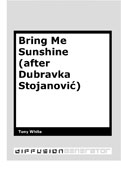
Download A4 | US Letter PDF 417Kb
About : ‘Bring Me Sunshine (after Dubravka Stojanovic)’ continues Tony White’s Balkanising Bloomsbury project. The story was created by cutting up, remixing and re-narrativising fragments from various sources including London’s Metro newspaper, and transcripts from the trial of Slobodan Milosevic at the International Criminal Tribunal for the Former Yugoslavia (ICTY) to create a completely new story. A number of pilot publications in the Balkanising Bloomsbury series were previously published as part of a Diffusion case study residency in November 2007.
Published December 2008
Tony White is a writer and author of novels including Foxy-T (Faber and Faber) and the non-fiction work Another Fool in the Balkans. He co-edited the fiction anthology Croatian Nights (Serpent’s Tail/VBZ) and edited the Brit-pulp collection (Sceptre). Tony has edited and published the artists’ book imprint Piece of Paper Press since 1994 and produced fiction in collaboration with visual arts and interdisciplinary projects by London Fieldworks, Bob and Roberta Smith, Alison Turnbull, Chris Dorley-Brown and others. Tony is currently writer in residence at the UCL School of Slavonic and East European Studies (SSEES) supported by the Leverhulme Trust through their artists in residence programme.

Download A4 | US Letter PDF 376Kb
StoryCube A4 only PDF 752Kb
About : along the beach – a disturbing but enlightening encounter. Sixth in a series of 6 eBooks and StoryCubes published weekly, feuilleton style.
Marseille Mix
My first encounters with Marseille were in the cinema, in films such as The French Connection, La Ville est Tranquille and Taxi. It seemed a strange place, dangerous, not conventionally beautiful, down at heel, but somehow attractive. I decided on the basis of this cinematic introduction that this was the city I wished to write about – exactly because it did not coincide in any way with what I considered to be a city, because of its defiance.
Marseille is an irreconcilable mix – of different cultures, different societies, different ideas about the planning, different images, different gastronomies. It evokes fantasy as much as objectivity. As a city it inspires dislike and fear but also pride and love.
It is not possible to investigate this city in a linear, coherent fashion, since the city is in no way linear or coherent.
Marseille Mix contains various methods of writing – narrative, essay, recipe, lists, conversations, chance remarks, and others. Sometimes it flows easily enough, sometimes it accepts the need for contradiction, disruption, lack of resolution. Of course the book is not really exactly like the city – it is a personal investigation, with its own points of view.
Published November 2008 in the Diffusion Transformations Series
William Firebrace is an architect, and teaches in various London schools of architecture. He has published one book, Things Worth Seeing (Black Dog 2001), has completed a second, Awake, and is now finishing a third, Marseille Mix, which should appear in 2009.
Unit 2, Bartlett School of Architecture, UCL

Download
Part 1 A4 | US Letter PDF 345Kb
Part 2 A4 | US Letter PDF 395Kb
Part 3 A4 | US Letter PDF 380Kb
Part 4 A4 | US Letter PDF 290Kb
Selected and Introduced for Short Work by Stephen Bury, Head of European and American Collections at the British Library
Thomas Carlyle, ‘Hudson’s Statue’ in Latter-day Pamphlets (1850)
The writer and historian, Thomas Carlyle (1795-1881), is an acquired taste – Pursewarden, in Lawrence Durrell’s Alexandria Quartet (1962), described his work as “haggis of the mind”. Nor have Carlyle’s ideas on democracy endeared him to the 20th and 21st centuries.
‘Hudson’s Statue’, dated 1st July 1850, is the seventh in the series, Latter-day Pamphlets. George Hudson was a railway speculator – the ‘Railway King’ – and Carlyle uses the proposal to make a statue of him as the armature of a pamphlet that explores whom his contemporaries think are heroic, and therefore worthy of worship. As Hudson’s speculative empire burst in 1849, the statue was never built, but this does not stop Carlyle making it into a – literally – obscene reality, and which he remorselessly uses to examine mid-nineteenth century England.
Today, when there are doubts about the USA prescribing one-man one-vote democracy for all cultures, we can begin to see some point in Carlyle’s caustic rant. And at a time we hero-worship minor celebrities or make proposals for the fourth plinth in Trafalgar Square, ‘Hudson’s Statue’ can be usefully – if not pleasurably – re-read. Are we any less gullible than those Englishmen who subscribed £25,000 to erect a statue in honour of this speculator and scoundrel?
The only reference that the modern reader might struggle with is Daniel Lambert (1770-1809), a Leicestershire man, who became notoriously fat and charged admission for the public to see him.
Stephen Bury
December 2008
Thomas Carlyle (1795-1881) was an essayist, satirist and historian, perhaps most famous for his book Sartor Resartus.

Download A4 | US Letter PDF 376Kb
StoryCube A4 only PDF 752Kb
About : turn down the heat – a gastronomic investigation. Fifth in a series of 6 eBooks and StoryCubes published weekly, feuilleton style.
Marseille Mix
My first encounters with Marseille were in the cinema, in films such as The French Connection, La Ville est Tranquille and Taxi. It seemed a strange place, dangerous, not conventionally beautiful, down at heel, but somehow attractive. I decided on the basis of this cinematic introduction that this was the city I wished to write about – exactly because it did not coincide in any way with what I considered to be a city, because of its defiance.
Marseille is an irreconcilable mix – of different cultures, different societies, different ideas about the planning, different images, different gastronomies. It evokes fantasy as much as objectivity. As a city it inspires dislike and fear but also pride and love.
It is not possible to investigate this city in a linear, coherent fashion, since the city is in no way linear or coherent.
Marseille Mix contains various methods of writing – narrative, essay, recipe, lists, conversations, chance remarks, and others. Sometimes it flows easily enough, sometimes it accepts the need for contradiction, disruption, lack of resolution. Of course the book is not really exactly like the city – it is a personal investigation, with its own points of view.
Published November 2008 in the Diffusion Transformations Series
William Firebrace is an architect, and teaches in various London schools of architecture. He has published one book, Things Worth Seeing (Black Dog 2001), has completed a second, Awake, and is now finishing a third, Marseille Mix, which should appear in 2009.
Unit 2, Bartlett School of Architecture, UCL

Download A4 | US Letter PDF 286Kb
December 10th 2008 is the 60th Anniversary of the adoption of the Universal Declaration of Human Rights by the United Nations General Assembly. It is the foundation of international human rights law, the first universal statement on the basic principles of inalienable human rights, and a common standard of achievement for all peoples and all nations.
Proboscis is re-publishing the Declaration as an eBook in the spirit of the 60th anniversary campaign’s aim to help people everywhere to learn about their human rights, “it is timely to emphasize the living document’s enduring relevance, its universality, and that it has everything to do with all of us.”
As the Declaration’s custodians and beneficiaries, all of us must reclaim the UDHR, make it our own. While we are entitled to our human rights, we should also respect the human rights of others and help make universal human rights a reality for all of us. In our efforts lies the power of the UHDR: it is a living document that will continue to inspire generations to come.
First Published in 1948
Sourced from the United Nations

Download A4 | US Letter PDF 377Kb
About : An Agreement of the Free People of England is a key manifesto arising out of the tumult of the English Civil Wars and, specifically, the vision of John Lilburne, Richard Overton, William Walwyn and Thomas Prince. It sets out to be a model for an English Constitution, referring back to the 1628 Petition of Rights, which itself confirmed numerous rights and liberties. It called for freedom from absolute power through representative government, elected for one year only by all men over 21 (though not quite universal suffrage); the removal of privileges and exemptions from the law; ban on serving military officers being elected to parliament; the abolition of corruption; the right to silence in court; legal cases to be heard in English and charges against them to be heard by defendants; trial by jury; a limit on term of office and separation of powers between legislature and judiciary; an elected judiciary; civilian control of the military ; freedom of conscience and right to conscientious objection; right to life, liberty and freedom without imprisonment for debt or without due process of law; fair taxation and free trade not monopolies.
At at time when the powers of parliament and civil liberties are being eroded by the executive and police can search an MP’s office, seize material and arrest the MP without a warrant, it is ever relevant to reflect back on our radical past and the establishment of our current democracy. Visionaries like John Lilburne remind us that what we cherish are our ‘freeborn rights’ – protected by the State but not bestowed by it. In those turbulent times three civil wars and the Glorious Revolution were needed to establish the primacy of government by elected representatives – Parliament’s role as overseer of the executive is the bastion against any over zealous government whittling away at those rights,
having by wofull experience found the prevalence of corrupt interests powerfully inclining most men once entrusted with authority, to pervert the same to their own domination, and to the prejudice of our Peace and Liberties
Liberty’s Guide to Human Rights
John Lilburne (1614–1657), also known as Freeborn John, was an agitator in England before, during and after the English Civil Wars of 1642–1650. From 1638 he engaged in unlicensed publishing championing the ‘freeborn rights’ of all. A Lieutenant-Colonel in the Parliamentary Army he fought at Edgehill, Brentford, Marston Moor and Tickhill Castle. Imprisoned in 1645 he wrote the first version of An Agreement for the People which became the focus of the Leveller contingent in the New Model Army’s 1647 Putney Debates. Lilburne was imprisoned by Cromwell in 1649 virtually until his death in 1657.
Richard Overton (c.1599-1664)
William Walwyn (c.1600-1681)
First Published May 1649
Sourced from The Constitution Society

Download A4 | US Letter PDF 463Kb
About : In September 2007 Tate Modern announced Stewart Home had begun a year-long engagement as writer-in-residence at their Level 2 Gallery. His brief was to write texts responding to exhibitions showcasing new emerging international artists. This publication reproduces some of those texts.
Published December 2008
Stewart Home is an artist who has used social networking sites such as MySpace as the location for much of his non-gallery work in recent years. He is also the author of many books of fiction and cultural commentary, including 69 Things to do With a Dead Princess (Canongate, 2002), and The Assault on Culture: Utopian current from Lettrisme to Class War (AK Press 1991). His latest novel is Memphis Underground (Snowbooks, 2007). Online resources relating to Stewart Home’s work can be found at
www.stewarthomesociety.org

Download A4 | US Letter PDF 708Kb
About : Transcriptions of prank calls to prostitutes that demonstrate how commodified sex, like everything else done in an alienated society purely for money, lacks excitement and imagination.
Published December 2008
Stewart Home is an artist who has used social networking sites such as MySpace as the location for much of his non-gallery work in recent years. He is also the author of many books of fiction and cultural commentary, including 69 Things to do With a Dead Princess (Canongate, 2002), and The Assault on Culture: Utopian current from Lettrisme to Class War (AK Press 1991). His latest novel is Memphis Underground (Snowbooks, 2007). Online resources relating to Stewart Home’s work can be found at
www.stewarthomesociety.org



